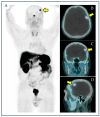The Prevalence and Significance of Incidental Positron Emission Tomography Findings in the Brain Using Radiotracers Other than [18F]FDG: A Systematic Review and Meta-Analysis
- PMID: 40428197
- PMCID: PMC12110180
- DOI: 10.3390/diagnostics15101204
The Prevalence and Significance of Incidental Positron Emission Tomography Findings in the Brain Using Radiotracers Other than [18F]FDG: A Systematic Review and Meta-Analysis
Abstract
Background: Incidental brain imaging findings could be clinically relevant, and advancements in molecular imaging could lead to their more frequent identification. The aim of this review is to establish the prevalence and clinical significance of brain incidentalomas at PET (BIPs) using radiotracers other than [18F]FDG. Methods: A comprehensive literature search of studies about BIPs was carried out. Four different databases (PubMed/MEDLINE, EMBASE, the Cochrane library, and Google Scholar) were screened up to December 2024. Only original articles about BIPs using radiotracers other than [18F]FDG were selected. A proportion meta-analysis of the prevalence of BIPs was carried out using a random-effects model. Results: Fourteen studies were included in the review, using somatostatin receptor (SSTR) PET (n = 6), radiolabeled choline PET (n = 5), prostate-specific membrane antigen (PSMA) ligands PET (n = 1), [18F]Fluciclovine PET (n = 1), and [18F]FDOPA PET (n = 1). The pooled prevalence of BIPs was 4.6% for SSTR PET, 1.1% for choline PET, 1.2% for PSMA ligands PET, 2.5% for [18F]Fluciclovine PET, and 3.9% for [18F]FDOPA PET. When BIPs were further evaluated using MRI, meningiomas were the most frequent lesions detected, but both benign and malignant lesions could be incidentally diagnosed. Conclusions: BIPs using radiotracers other than [18F]FDG are not rare, in particular at SSTR PET, further justifying the extension of PET scans to the brain when radiotracers other than [18F]FDG are used. When detected, a BIP should be further evaluated using brain MRI. Both benign and malignant lesions could be incidentally detected in the brain. Further studies are warranted to better clarify the clinical impact of BIP detection.
Keywords: PET; brain lesions; brain metastases; brain tumors; incidental; incidentalomas; meningioma; neuro-oncology; neuroimaging; nuclear medicine; positron emission tomography.
Conflict of interest statement
The authors declare no conflicts of interest.
Figures
References
-
- Alabousi M., Wilson E., Al-Ghetaa R.K., Patlas M.N. General Review on the Current Management of Incidental Findings on Cross-Sectional Imaging: What Guidelines to Use, How to Follow Them, and Management and Medical-Legal Considerations. Radiol. Clin. N. Am. 2021;59:501–509. doi: 10.1016/j.rcl.2021.03.002. - DOI - PubMed
Publication types
LinkOut - more resources
Full Text Sources
Miscellaneous



